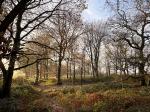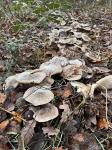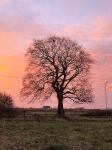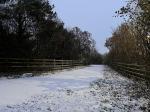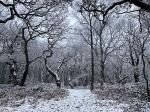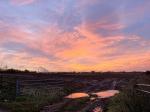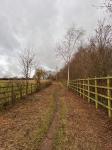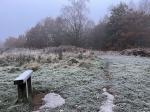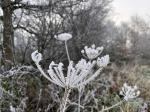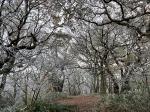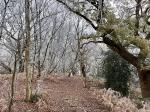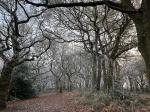Brayton Barff Through the Seasons.
Set in the Vale of York, South West of the market town of Selby and between the villages of Thorpe Willoughby and Brayton, lies Brayton Barff, a sandstone Hill approximately one hundred and fifty feet in height which was formed by glacial movement during the last Ice Age. It is a significant landmark in an otherwise flat landscape.
Today the site is primarily owned by Yorkshire Water with Selby District Council owning a small patch of the land adjacent to the A63 Selby bypass. A large underground reservoir occupies the centre of the site which delivers water to around 4.7 million customers throughout Yorkshire.
Within the Barff woodland over 40% of the trees are Sessile Oak which are generally found in semi natural woodlands in the north of the country. These trees are so called because its acorns are not held on stalks, like those of the English Oak (Pedunculate), but attached directly to the outer twigs. There are also several English Oak trees as well as some cross-hybrid oaks. These trees are known to support many species of flora and fauna, invertebrates, mosses, lichen and fungi.
During the Victorian times it is thought that the shipbuilders on the east coast would come over to the Barff for selected cuts of timber to build their sea going vessels.
The Barff also has a variety of other trees including Silver Birch, Beech, Sycamore, Holly, Rowan, Scots Pine, Alder, Hawthorne and European Larch. There are also several Yew, Willow, Hazel, Horse Chestnut and Wych Elm. As with similar woodlands there are a variety of bushes, including Honeysuckle, Elderberry, Gorse, Broom and Buddleia.
The history of Brayton Barff is quite vague, apparently during 1803 a beacon was lit on the Barff when the country was threatened with an invasion by Napoleon. In May 1935, to celebrate King George V's Silver Jubilee, a Bonfire was lit on the Barff as part of the celebrations.
Early issues of Ordnance Survey Maps dated 1903 clearly show a rifle range on the Barff, extending out to Mill Lane. During the 
Between 2001 – 2004 the A63 Selby bypass, 10km twin lane single carriageway was constructed which severed the South West corner of the Barff, adjacent to Selby Golf Course and resulted in a slight redesign of several holes on the golf course. Wooden fencing was erected as a result of this new road running alongside of the Barff and a footbridge constructed over the ‘new road’ following the line of the Bridal way which extends from Mill Lane. Around 2005/2006 a definite 2metre wide limestone aggregate footpath was laid forming a circular path around the outer edges of the woodland. This footpath is approximately 1.2 miles in length and takes about 30 minutes to circumnavigate at a leisurely pace.
In 2012 the Barff was declared an Ancient Oak Woodland and as such throughout 2012 and 2013 significant work had been carried out by the relevant agencies to cut and remove large swathes of non-native trees, creating at that time huge scars on the landscape. Some three years later the planting of the native trees have become well established and are flourishing. Ongoing maintenance work on the footpath around the bottom of the Barff was completed during the Summer of 2016.
A second phase of woodland maintenance commenced during the Autumn of 2019 with the removal of many old and diseased trees and the cutting back of the Gorse and Broom bushes, especially adjacent to the ‘bypass trail’, this work continued through till March 2020 with re planting continuing into April 2020.
Brayton Barff is a popular site for walkers and bird watchers alike and a path circling the outer perimeter of the Barff makes a pleasant thirty minute walk, giving views looking over towards Selby and the village of Brayton as well as the power stations of Drax and Eggborough..jpg)
For the early risers it is a great place to see some stunning sunrises over the villages of Brayton looking towards Drax Power Station, the same with the Sunsets looking over towards Eggborough and Monk Fryston.
The Barff changes with the Seasons and every visit can reveal something new, the woodland is a haven for wildlife. Records show that since 1982 one hundred and twelve species of bird have been seen in the woodland and at least 40 of those have bred here, including Tawny Owl, Buzzard, Green Woodpecker, Spotted Flycatcher, Goldcrest and Nuthatch to name just a few. On average over 70 species of bird are recorded each year. Further details of the bird life on the Barff can be found on the Brayton Barff Group Facebook page, especially the posts from Derek Cooper. Today ‘The Friends of Brayton Barff group’ led by Derek and a small team of volunteers help keep and maintain the cleanliness of the site as well as recording the wildlife and bird sightings.
The Barff is also home to fifteen different species of mammals, including Muntjac Deer, Pipistrelle Bat, Fox, and Field Vole.
Over eighty species of plant and wildflowers have been recorded, included Bee Orchid, Northern Marsh Orchid, Wood Anemone, Marsh Ragwort, Bluebell, White Bluebell, Bittersweet and Purple and White Foxgloves. Over twenty species of Butterfly have been recorded, including Marbled White, Brown Angus, Speckled Wood, Comma and Brimstone.
During the Autumnal months fungi thrives in this woodland environment, species including Fly Agaric, Beefsteak Tree Fungi, Chicken of the Wood, Sulphur Tufts, Stinkhorn, Ink cap, Puffballs and Hoof Bracket are just some of the many varieties that can be found here.
Click on the galleries shown below to expand the albums.
December 2023
My ramblings on the Barff continued throughout December less a couple of days whilst I had to care for one of my dogs who had just recently had a procedure carried out at the veterinary practise.
December on the Barff has been exceptionally wet resulting in the ground and surrounding area becoming waterlogged. We saw our first snow of the winter early on in in the month and several morning frosts. Christmas Eve morning saw the temperature rise to 13c. Several highlights for me were listening to the Tawny Owl close to the old pump house, listening to the Linnets in the Mase field, and watching the beautiful sunrise in the East. Fungi continues to flourish in the woodland as do the stray wildflowers. As the month comes to a close the Song Thrush and Coal Tits has come to the fore producing some lovely morning choruses to cheer up the sole on even the dampest of mornings.
A cold frosty and foggy start to the 1st day of the month. It was –2c at 7.00am with the air temperature remaining around the freezing mark all day. The fog barely lifted for just a couple of hours over lunchtime. The frozen fallen leaves crunching under foot as I walked over them. A pair of Crows were squawking to each other in the distant field which broke the silence on this morning's walk. The cold northerly wind sent a chill down the spine as I carefully made my way through the undergrowth to look at some fungi on a moss-covered rotting tree trunk.
Saturday 2nd our coldest morning of the winter so far, the car temperature gauge was reading just –4c at 7.30am, with a penetrating overnight ground frost. Although dusky dark and quite foggy the Barff certainly had its winter coat on this morning, the long grasses, nettles, and brambles were covered in a fine white haw frost. The ground was beginning to firm up and had a definite crunch as I carefully walked over the frozen leaves, being careful not to stand on any of the wet and slippery tree roots. The frost had certainly transformed the woodland this morning with some delicate frosty spider’s webs woven amongst the dried wildflowers, some like works of art shimmering lightly in the gentle cool breeze.
Sunday 3rd, the snow has finally arrived overnight. We woke up this morning to about an inch of snow. The roads were quite perilous early this morning, I arrived on the Barff for 7.00am, it was a ‘little warmer’ than yesterday morning at 0c, but still quite nippy on my finger ends, I really need to find my gloves. it was still dark as we arrived on the Barff, though the snow made it a little lighter. The snow certainly transforms the landscape, Blackbirds were busily searching for food under the leaf litter. The Oak leaves were falling from the young trees like confetti.
Tuesday 5th, it has rained now on the Barff for the last 24 hours without a break and this morning the rain continued, it was another wet dull and rainy morning, the smaller tracks around the Barff are heavily waterlogged and quite slippery. We have a Woodcock taking up residence on the Barff this winter, Meg initially flushed it up several weeks ago weeks alongside one of ‘Sherwoods’ fields and again this morning in a similar place. It had been taking shelter under some of the undergrowth adjacent to the perimeter fence. They are quite a rare bird to see on the Barff, they are quite chunky, pigeon-sized birds with short, greyish-pink legs and an exceptionally long, straight bill. They are mostly brown, with an intricate pattern of black and grey barring, and broad, dark bars across the crown and blend in very nicely with the autumn-coloured ferns.
Thursday 7th, what a contrast to yesterday, I was on the Barff early yesterday morning around 6.30am, obviously it was dark but, on this occasion, it was pitch black, it was bitterly cold with a light northerly breeze, after the overnight frost. Within a few moments I heard a Tawny Owl squeaking higher up in the trees, I think my headlamp must have disturbed it. The temperature barely broke above freezing all day, by bedtime the frost had gone deep into the ground. What a difference this morning, I was expecting a lovely frosty morning and woke up to rain and a much milder morning.
Saturday 9th we woke up to another wet morning of persistent rain, I added an extra loop on my walk this morning and headed off along the Bypass trail as a change from my weekday walk, mainly because it is easier to get across the bypass at the Mill Lane junction with much less traffic than during the week. It was good to see that the council have been along the bridal path (along the golf course side) this week with some heavy grass/shrub cutting equipment and restored the path back to how it should be maintained, I wonder when the Barff side of the path will be cut back? Considering the amount of rain we have had since the beginning of December and the cooler temperatures, I am amazed how much fungi there still is in the woodland so late into the year, Yellow Brain Fungi, Birch Polypore, Earthballs and Candle Snuff can still be seen.
I learnt some interesting rain facts just recently, namely that over the Barff in the last five months we have had over 500mm of rain. For several years now we usually get half that amount of rain fall in a year. Putting this into some form of perspective, 500mm of rain equates to 400 million litres, enough to fill over 150 Olympic swimming pools!
Tuesday 12th was another dull miserable day, the Barff is soddened and exceptionally muddy especially on the top of Tap Hill, though puddles are now forming on the main perimeter footpath around the bottom of the woodland. It was good to see the council contractors with some heavy machinery clearing the Bridal path adjacent to the Barff today, this had become very heavily overgrown over several years with Blackthorn, Willow and especially Brambles bushes.
Sunday 17th, another beautiful morning, two on the trot now, dry, bright, with sunshine later, and a colourful bright sunrise around 7.55am. Although the perimeter track is wet and muddy the tracks higher up the woodland and on the summit are still quite wet and sodden. Lots of bird song has filled the air, Robins have been quite chirpy and tend to follow me as I wander around, flocks of Long tailed tits have been very vocal this past two days, as have the Wrens and Goldcrest, even the Tree Creepers have been noisy as they go about their business running up and down the tree trunks looking for some juicy grubs. A Skeen of Geese flew over the Barff this morning heading to the wetlands at Fairburn.
Monday 18th, I was on the Barff for 6.00am this morning as I had an important meeting in York at 9.15am. As to be expected at that time of day it was extremely dark, the moon was well shrouded in mist, the three of us had the Barff to ourselves at this time of day. It was lovely, quiet, and peaceful. We startled one or two Wood Pigeons as we passed under them, their wings flapping at an alarming rate which broke the silence of the woodland as they flew to another tree close by, several Crows joined in the fracas for a few moments until their panic was over. Although still very dark the Blackbirds were busily scavenging for food amongst all the leaf litter. It was nice to hear one of the Tawny Owls calling, its screeching alarm call quite unmistakable as it fills the dark still morning air.
I had a couple of days away from the woodland this week due to one of my dogs having a significant procedure at the veterinary which prevented any walks for at least 48 hours, fortunately after two days she had recovered significantly to resume with short walks.
The week leading up to Christmas was very wet and blustery which eventually brought the last of the stubborn Oak leaves off the trees. The wind increasing late afternoon resulting in several trees falling and lots of fresh kindling on the woodland floor.
Sunday 24th Christmas Eve was another blustery morning, but today the morning air temperature was a barmy 13c, warm enough for me to wear my waistcoat jacket instead of a heavy waterproof jacket. I spent several minutes watching three young Grey Squirrels playing tig with each other, scurrying up, down and round some of the old Oak trees at an alarming speed, they have no fear or worry about falling off or losing their grip as they have exceptionally long sharp nails. Grey Squirrels do not hibernate over the winter months and are well equipped to withstand the cold wet winter weather, their thick fur coats keep them warm, they are able to store fat in their bodies to help them survive periods when food is scarce. They also spend a lot of time during the Autumnal months gathering food and stockpiling acorns to last them through the winter. They manage to survive the winter by being prepared, staying warm, and having a little help from each other.
The milder weather today gave the birds a boost, as well as Blackbirds and Robins, there were lots of Chaffinch about, flitting amongst the trees. Wrens were very vocal singing their heads off especially around the old pump house.
Monday 25th Christmas Day was a dull and wet drizzly morning, a little cooler that yesterday at 9c. It was quiet on the Barff this morning. Heavy overnight rain had made the paths very wet and slippery in places. Birdsong this morning was led by Chaffinch, Brambling and Robin. It was nice to see the first signs of Spring with some little green shoots of the Bluebells just poking through the soil, though they are still well hidden under the leaf litter.
Tuesday 26th December, Boxing Day. A lovely crisp and bright morning, 5c, such a change from the past week or so. Robins and Chaffinch accompanied me along the bridal path this morning, their chirping and bird song resounding in the still quiet air.
Wednesday 27th, was a very wet and windy morning, in fact it was that wet that I had to put the dog’s winter waterproof jackets on them before we set off on our walk on the Barff, compounded by a strong South Westerly strengthening wind. The strengthening wind has blown one of the trees over the wooden fence into the car park resulting in some of its branches covering at least two parking places. hopefully no cars were damaged. It has been very quiet on the Barff this past few days though I heard a flock of Linnets feeding in the Maze field, picking up the spoils of the crop that was harvested earlier this month.
Sunday 31st December was another cold, dull and miserable morning, and with the air temperature hovering at 5c it was quite a chilly start to the mornings walk around the woodland. The entire Barff is now completely waterlogged, not helped in part by last night’s heavy overnight rain, although the main perimeter footpath is still quite clear most of the tracks branching off the footpath are extremely muddy and slippery. It was good to see someone had been in the car park and cut back the fallen tree which now frees up at least three parking places.
It was relatively quiet amongst the trees this morning, Blackbirds were doing low passes across the footpaths in their constant search for food, occasionally stopping on a nearby branch to alarm call, their shrill unmistakable song breaking the silence. It wasn’t until we reached the Bridal path adjacent to the bypass that the birdsong started to come to life. A Song Thrush was heartily singing its head off accompanied by a Robin, both birds heavily sheltered from the drizzle hiding under the cover of the Bramble bushes which run along the side of the footpath, continuing our walk towards Mill lane I disturbed a small flock of Crows which had been scavenging some roadkill on the bypass, shortly followed by a pair of Magpies hoping for a free meal from the crows. Crossing the A63 bypass at the Mill Lane junction we headed along the freshly cleared Bridal path up the hill back towards the Barff, a small flock of Long Tailed Tits were chirping amongst the Holly bushes along with several Goldcrest. The walk was rounded off when a small flock of what looked like Pink Footed Geese flew overhead heading towards the reserve at Fairburn, what a lovely way to end this morning’s walk and 2023.
I will take this opportunity to wish you and your family a Very Happy New Year.
|

